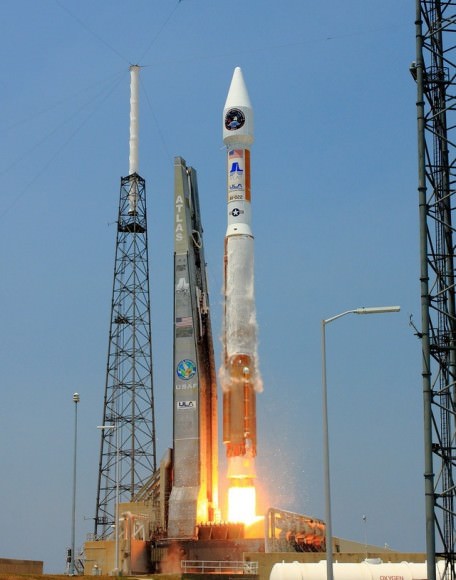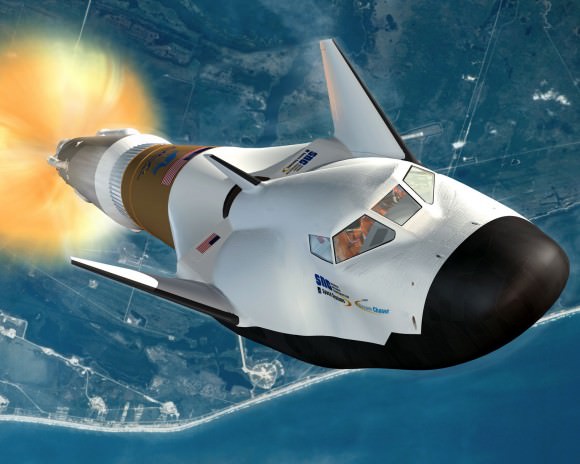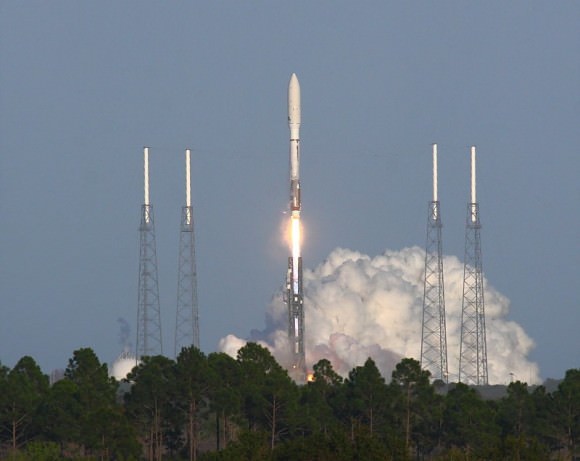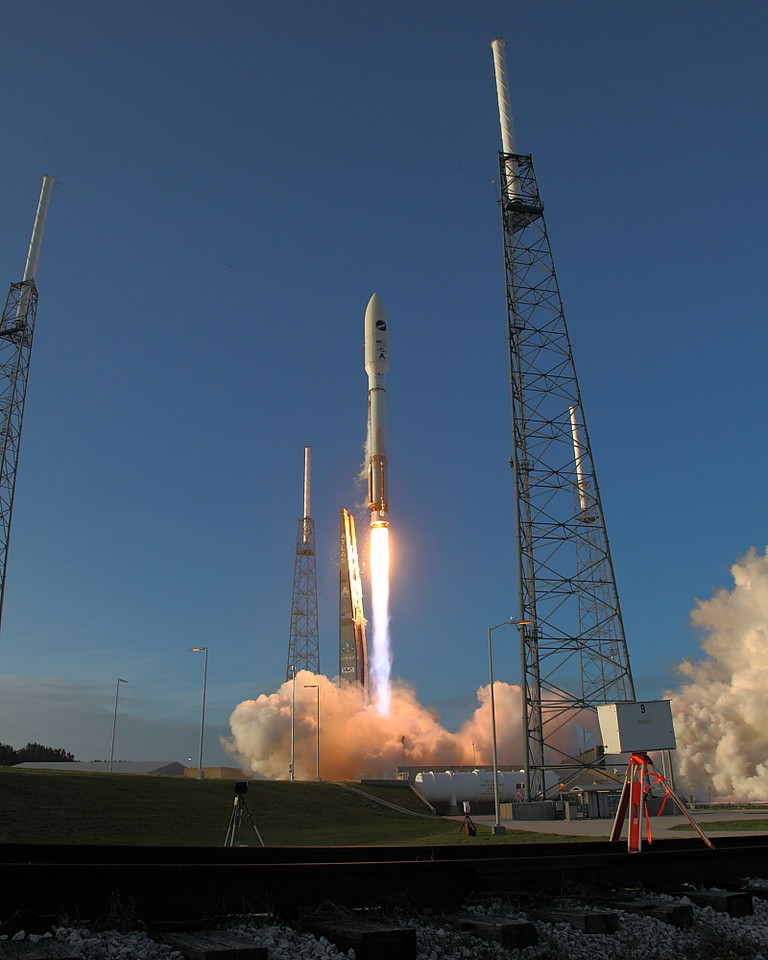[/caption]
CAPE CANAVERAL Fla. — NASA is looking for a few good rockets – that’s right, plural. While it continues to review the Space Launch System or SLS – it has inked a non-funded agreement with United Launch Alliance (ULA) to utilize the Denver-based firm’s Atlas V rockets to send astronauts into orbit. The announcement was made at Kennedy Space Center in Florida on Monday.
The Space Act Agreement signed by the space agency and ULA will see critical information regarding the flight characteristics of the Atlas V be provided to NASA. ULA will not be alone in providing information however; NASA will give ULA vital data regarding its experience sending humans into orbit as well as guidance as how to adapt the Atlas V for human space flight purposes. NASA will help ULA with both the crew transportation system capabilities as well as the human certification requirements.
This will begin a process where ULA and NASA will work closely with one another to guide the Atlas V toward being man-rated. Before that can happen there are numerous pertinent issues that have to be reviewed first, such as the cost involved and other issues involved with the certification process.

The Atlas V is an expendable launch vehicle that has not only been used by NASA, but the Department of Defense (DoD) as well. The Atlas’ proven track record should allow a large portion of the study to be completed before the end of this year.
NASA’s part of the arrangement includes providing milestone briefings and technical reviews to check and see how the project is progressing as well as identifying risks and attempting to mitigate them.
ULA meanwhile will use its own funds to pay for the Crew Transportation System (CTS). Design maturation, required analyses (including hazard reviews that are unique to human space flight efforts) as well as establishing a man-rated baseline for the Atlas V all will be handled by United Launch Alliance.
The rationale behind why the Atlas V was specifically selected is simple, both Sierra Nevada Corporation and Blue Origin’s proposals under the Commercial Crew Development – 02 (CCDev-02) contract – utilize the Atlas V. Bigelow Aerospace has also looked at the rocket as a launch service provider.

“I am truly excited about the addition of ULA to NASA’s Commercial Crew development Program team,” said NASA Administrator Charles Bolden. “Having ULA on board may speed the development of a commercial crew transportation system for the International Space Station, allowing NASA to concentrate its resources on exploring beyond low
Earth orbit.”
The Atlas V has had 26 consecutive successful flights, making it an easily one of the front runners to potentially send astronauts to orbit.
“We believe this effort will demonstrate to NASA that our systems are fully compliant with NASA requirements for human spaceflight,” said George Sowers, ULA’s vice president of business development. “ULA looks forward to continued work with NASA to develop a U.S. commercial crew space transportation capability providing safe,
reliable, and cost effective access to and return from low Earth orbit and the International Space Station.”



What a waste of money! Why does NASA claim to be supporting commercial ventures and then throwing money at companies to fulfill their agenda. Mr. Bolden cannot produce a heavy launch, and insists on having “an open competition” for the boosters. This is pure hypocracy! What NASAbama is really doing is simply supporting companies from their voting base. They refused ATK’s Liberty rocket for CCDev2, and now they turn around and throw money at another “commercial” company to do the same thing at a much higher cost, a less proven track record (although not too bad) and with a lower safety margin. If they truly want to advance space flight, why are they continuing to go after new businesses (NOT new technology) when savings already exist with well-developed products.
I’m sorry, where do you see “Throwing money”? I see “non-funded agreement” which means no money changes hands. Could you reply with where in the article you are seing where NASA is “Throwing money”?
@Tony,
If NASA is using any of the folks at NASA in this, and they are from the agreement — that IS tossing money, money these folks are paid to work at NASA on a daily basis, or did you think these folks would put in the time off the work clock.
The fact that ULA is putting their own money into figuring out how to do what NASA wants with the system(s) they control does not mean they will not be paid in the long run (if the work pays off and they get contracts for example). There is no such thing as a free lunch dude.
Mary
So your proposing that the people who work for NASA should be fired? If they aren’t working on this then they would either have to be given work to do in another area/project, be payed the same money to do nothing, or be fired. I personally would rather see the skills remain in NASA. How much has it cost NASA already to train and teach the necessary skills and process to these people only for you to come along, give them a very generous severance package and allow them to walk into private industry, their skills forever lost to NASA, or at least never to be bought so cheaply. Space exploration is a long term venture, your apparently thinking short term. That won’t get anyone very far.
@Tony,
What you are saying makes a sort of good sense, but only so far as NASA has deep pockets which can benefit corporate interests such as ULA R&D in the form of manpower “they have to be paid anyway and let’s use them (NASA folks) here in this non-funded project” way. Borrowing talent and not paying for that talent is what ULA is doing here, as you have said above.
No, I did not say fire anyone, although I am sure there are several, there always are, persons who need to be sacked, within the structure of NASA, this in NOT my point. My point is there IS funding if only to the extent of the time and effort paid to NASA employees by NASA who interact with ULA for this non-funded agreement. I mean let’s call it what it seems to be please.
As I said above:
“The fact that ULA is putting their own money into figuring out how to do what NASA wants with the system(s) they (ULA) control does not mean they (ULA) will not be paid in the long run (if the work pays off and they (ULA) get any contracts for example). There is no such thing as a free lunch, dude.”
====
You say:
Space exploration is a long term venture, your apparently thinking short term. That won’t get anyone very far.
I say:
This is short term thinking on YOUR part, I see the long view, why is this so hard for you to grasp? Do you think that NASA is a supporter of non-profit space development corporations. Even if that were true in “any case” it is not in this case, the one we are talking about. The folks at ULA already have their hands out and have had for years, re: CCDev1, ESD –still not finished and over cost, and yet to be even re-scaled on paper for either of the intended crafts. The SIMS are all that exist at present, do you think the actual physical test items will be free, maybe the implemented items will be free, nah, the final launch items will be the freebies, that’s gotta be right — the first taste is not free.
— read the CCDev1 ESD article–
“The EDS is the most significant modification required for either launch vehicle,” Sowers said.
… just a snippet…
“Spending a mix of private and public funds, ULA developed and demonstrated prototype EDS crew displays monitored by NASA mission control teams during a real Atlas 5 launch in August.”
— read the CCDev1 ESD article–
Again, I say, this is not non-funded for this part any more than the prior work with ULA for CCDev1. Along the line NASA pays, and pays.
My point is we need to get more for our NASA destined tax dollars, the dollars which do not exist within the tax collection system, the deficit dollars which all of us know too well. If there are to be far fewer of those dollars this belt-tightening needs to be more than just a show, more than what is happening.
If the pump needs priming I’m all for pouring the water in the pipe going into the well head, this, however, is not a prime example (pun intended).
“If I was a bettin’ man, I would bet on the piggins, cause pigs cain’t fly,” mis-attributed to many, wrongly.
Mary
How is this situation so different from the US Defense Department contracting Defense and Aerospace firms like Lockheed, Boeing, General Dynamics, etc. to build military aircraft and hardware? You can bet there are a number of former DOD employees working as “consultants” representing these same companies.
@William,
Your point is taken, William, and I understand exactly the representation you suggest.
But -the situation of the DOD, DOE, DHS and other TLA departments of the US (federal) Government is not the point being made here.
Since you brought it up however, I can say this, corporations wishing to ‘sell’ to the masses like us consumers create products, create a market, a distribution network, endpoint sales assistance programs, pay for facing rights on the shelves (it is not just the food folks, all markets have come to this). With the FedGov it works in a different and much more incestuous way, that is what drives this runaway bus. There are still products, markets, sales assistance programs and the like, and indeed as in the consumer market the bottom pays all above. In the example you are positing Federal Dollars is not the bottom buyer it is the bottom dollar you are betting. And these chickens will come home to roost.
Another very large difference –in our look inside the sausage factory that is the FedGov and the military/industrial complex beast which feeds on that limitless teat is this, how much does it matter to Joe Sixpack, how about Doug Donuts, maybe Lizy Lazybones cares about the issue. I see little to indicate any grassroots or groundswell from the teeming masses.
Ask them or lead them is the answer, what is the question being asked of our paid political leaders?
The current answer is not “ask them” it appears to me.
Mary
@Tony,
What you are saying makes a sort of good sense, but only so far as NASA has deep pockets which can benefit corporate interests such as ULA R&D in the form of manpower “they have to be paid anyway and let’s use them (NASA folks) here in this non-funded project” way. Borrowing talent and not paying for that talent is what ULA is doing here, as you have said above.
No, I did not say fire anyone, although I am sure there are several, there always are, persons who need to be sacked, within the structure of NASA, this in NOT my point. My point is there IS funding if only to the extent of the time and effort paid to NASA employees by NASA who interact with ULA for this non-funded agreement. I mean let’s call it what it seems to be please.
As I said above:
“The fact that ULA is putting their own money into figuring out how to do what NASA wants with the system(s) they (ULA) control does not mean they (ULA) will not be paid in the long run (if the work pays off and they (ULA) get any contracts for example). There is no such thing as a free lunch, dude.”
====
You say:
Space exploration is a long term venture, your apparently thinking short term. That won’t get anyone very far.
I say:
This is short term thinking on YOUR part, I see the long view, why is this so hard for you to grasp? Do you think that NASA is a supporter of non-profit space development corporations. Even if that were true in “any case” it is not in this case, the one we are talking about. The folks at ULA already have their hands out and have had for years, re: CCDev1, ESD –still not finished and over cost, and yet to be even re-scaled on paper for either of the intended crafts. The SIMS are all that exist at present, do you think the actual physical test items will be free, maybe the implemented items will be free, nah, the final launch items will be the freebies, that’s gotta be right — the first taste is not free.
— read the CCDev1 ESD article–
“The EDS is the most significant modification required for either launch vehicle,” Sowers said.
… just a snippet…
“Spending a mix of private and public funds, ULA developed and demonstrated prototype EDS crew displays monitored by NASA mission control teams during a real Atlas 5 launch in August.”
— read the CCDev1 ESD article–
Again, I say, this is not non-funded for this part any more than the prior work with ULA for CCDev1. Along the line NASA pays, and pays.
My point is we need to get more for our NASA destined tax dollars, the dollars which do not exist within the tax collection system, the deficit dollars which all of us know too well. If there are to be far fewer of those dollars this belt-tightening needs to be more than just a show, more than what is happening.
If the pump needs priming I’m all for pouring the water in the pipe going into the well head, this, however, is not a prime example (pun intended).
“If I was a bettin’ man, I would bet on the piggins, cause pigs cain’t fly,” mis-attributed to many, wrongly.
Mary
As you are aware, the second “C” in CCDev-2 stands for “Crew”. ATK’s bid (1) didn’t come with a crew vehicle, (2) other bidders (complete with crew vehicles) had declared their preferences for launch vehicles that didn’t include ATK’s last minute entry and (3) was unable to lift Orion. If you read the CCDev evaluation panel’s findings they point out in relation to ATK’s bid that “A significant weakness was the lack of any linkage to any spacecraft. ATK did not have any commitments, Memoranda of Understanding, or any partnership details from any spacecraft developer, nor did any spacecraft developer include the Liberty vehicle in their baseline CTS configurations.. Case closed.
ATK should have shown the decency and common sense to withdraw their bid. It’s almost as though they didn’t read the CCDev-2 rule book. Their bid had a “fanboy” name and a great paint job, but didn’t tick any meaningful boxes. Why expect NASA to have settle for a rerun of Ares 1 when there were options on the table that actually met the CCDev criteria?
“They refused ATK’s Liberty rocket for CCDev2…”
Among other things, Atlas V exists, known operational record. Liberty is nothing but paper.
26 successes, one anomaly (last stage early cut-off, delivered orbit lower than intended).
NASA (and the rest) decision is for an outsider a funny business, since the ULA CCDev1 contract to develop an Emergency Detection System (EDS) for human-rating the Atlas V launch vehicle was not finished in time. It wasn’t finished in the end of 2010 under the initial contract. It is still not finished after getting an April 2011 extension, undoubtedly one of the “numerous pertinent issues that have to be reviewed first … issues involved with the certification process.”
And now they may be stretching that project again:
“George Sowers, ULA’s vice president of business development, said the company developed a prototype Emergency Detection System last year and tested the design in a high-fidelity simulation lab in Denver.
The company, a joint venture between Boeing Co. and Lockheed Martin Corp., invited NASA officials and astronauts to participate in flight simulations of the Emergency Detection System, or EDS. The system is a computer designed to recognize an impending mishap and trigger an abort to pull astronauts away.
The goal, Sowers says, is to have the EDS ready to go when spacecraft builders start launching manned missions on the Atlas 5 or Delta 4.
“Most of our spacecraft are talking 2014 at the earliest for crewed flight, so we’re trying to protect that 2014 date,” Sowers said.”
When you are burned not once but twice, do you go back for a third failure to meet demand? Especially if a 1 year project becomes 4 years, or more?
********************
As background, I found the RAND 2006 comparison for the Secretary of Defense. They counted Atlas V and Delta IV as “immature” then, and discounted commercials that couldn’t satisfy the EELV requirements (mainly proven reliability, the performance be damned) while admitting that immature technology couldn’t either.
They also wanted more launches in order to maintain a reliability record. So ISS was a welcome addition.
If this is still the strategy beneath, the synergy of other commercials choosing the same vehicle is part of it. But the more vital reason may be that the system is at fault; it isn’t set up to mature more than the horse DoD (and then NASA) choses to bet on.
In which case the system isn’t geared towards commercials (well, duh) but a more “socialistic”(O.o) principle. That _should_ bother republicans, one would think.
26 successes, one anomaly (last stage early cut-off, delivered orbit lower than intended).
NASA (and the rest) decision is for an outsider a funny business, since the ULA CCDev1 contract to develop an Emergency Detection System (EDS) for human-rating the Atlas V launch vehicle was not finished in time. It wasn’t finished in the end of 2010 under the initial contract. It is still not finished after getting an April 2011 extension, undoubtedly one of the “numerous pertinent issues that have to be reviewed first … issues involved with the certification process.”
And now they may be stretching that project again:
“George Sowers, ULA’s vice president of business development, said the company developed a prototype Emergency Detection System last year and tested the design in a high-fidelity simulation lab in Denver.
The company, a joint venture between Boeing Co. and Lockheed Martin Corp., invited NASA officials and astronauts to participate in flight simulations of the Emergency Detection System, or EDS. The system is a computer designed to recognize an impending mishap and trigger an abort to pull astronauts away.
The goal, Sowers says, is to have the EDS ready to go when spacecraft builders start launching manned missions on the Atlas 5 or Delta 4.
“Most of our spacecraft are talking 2014 at the earliest for crewed flight, so we’re trying to protect that 2014 date,” Sowers said.”
When you are burned not once but twice, do you go back for a third failure to meet demand? Especially if a 1 year project becomes 4 years, or more?
********************
As background, I found the RAND 2006 comparison for the Secretary of Defense. They counted Atlas V and Delta IV as “immature” then, and discounted commercials that couldn’t satisfy the EELV requirements (mainly proven reliability, the performance be damned) while admitting that immature technology couldn’t either.
They also wanted more launches in order to maintain a reliability record. So ISS was a welcome addition.
If this is still the strategy beneath, the synergy of other commercials choosing the same vehicle is part of it. But the more vital reason may be that the system is at fault; it isn’t set up to mature more than the horse DoD (and then NASA) choses to bet on.
In which case the system isn’t geared towards commercials (well, duh) but a more “socialistic”(O.o) principle. That _should_ bother republicans, one would think.
So they are back to shooting astronauts into space on the top of a cold war ICBM, I despair.
That was many generations of ‘Atlas’ ago, Steve. It’s barely the same vehicle anymore. (Ironically enough, Atlas V uses Russian-made engines). Google ‘Atlas rocket’ and you’ll see.
For that matter, the Delta rockets have a heritage going back to the Thor IRBM, but you couldn’t really tell that anymore, either…
Also know that Soyuz rides an even more directly descended version of the R-7, their first ICBM and satellite launcher. They have yet to fly men on anything else (though a new spacecraft and launcher [Angara] may be in the offing for them)…
Can’t wait to see what is in store for the future of NASA!
Check out Swakker Shuttle and share your thoughts on the end of the NASA shuttle program and the Atlantis mission http://www.youtube.com/watch?v=QHrBhtNCvgY
@Swakker,
I noticed you had an app at that youtube vid, glad you thought to advertise here… not!
Mary